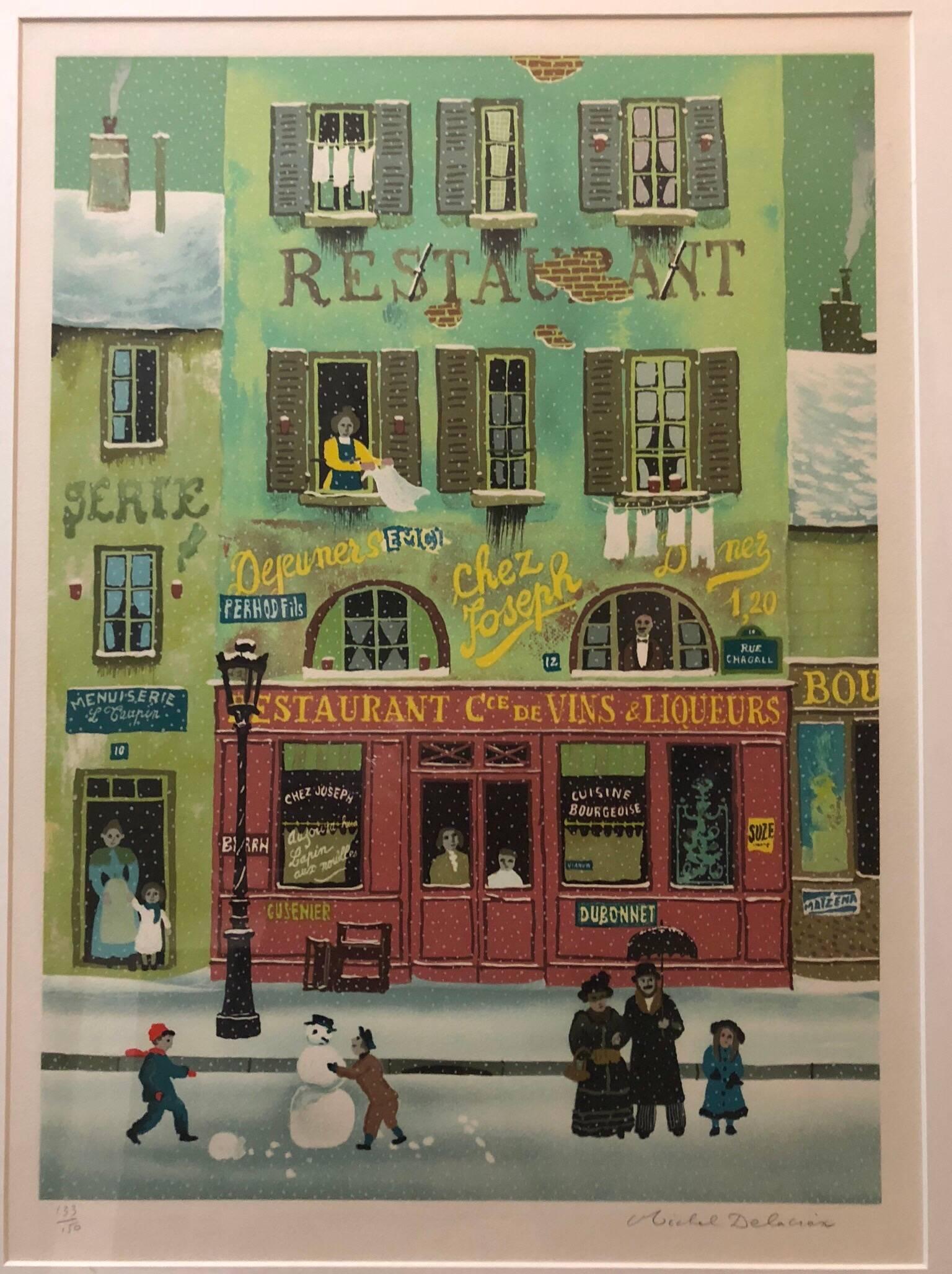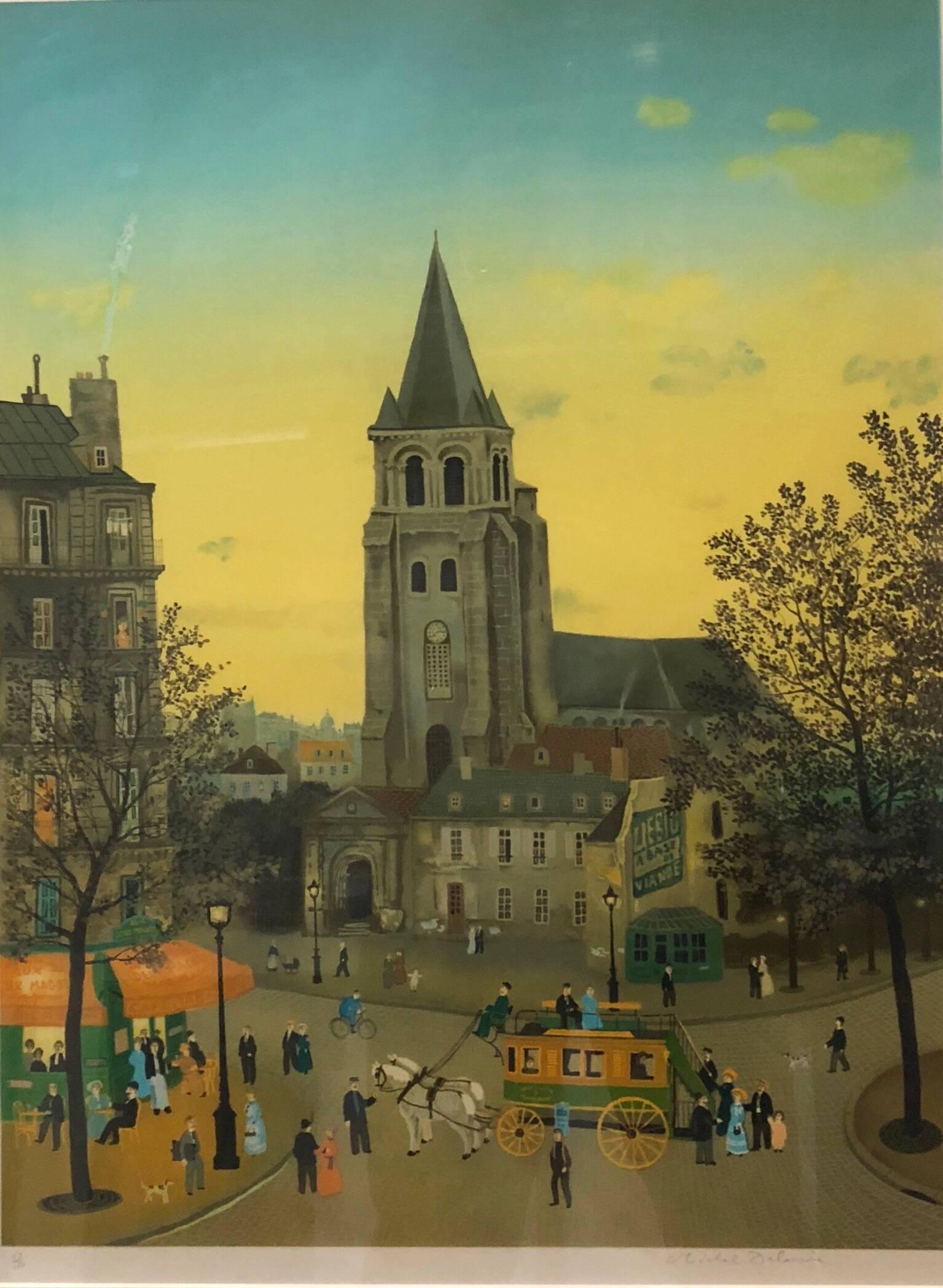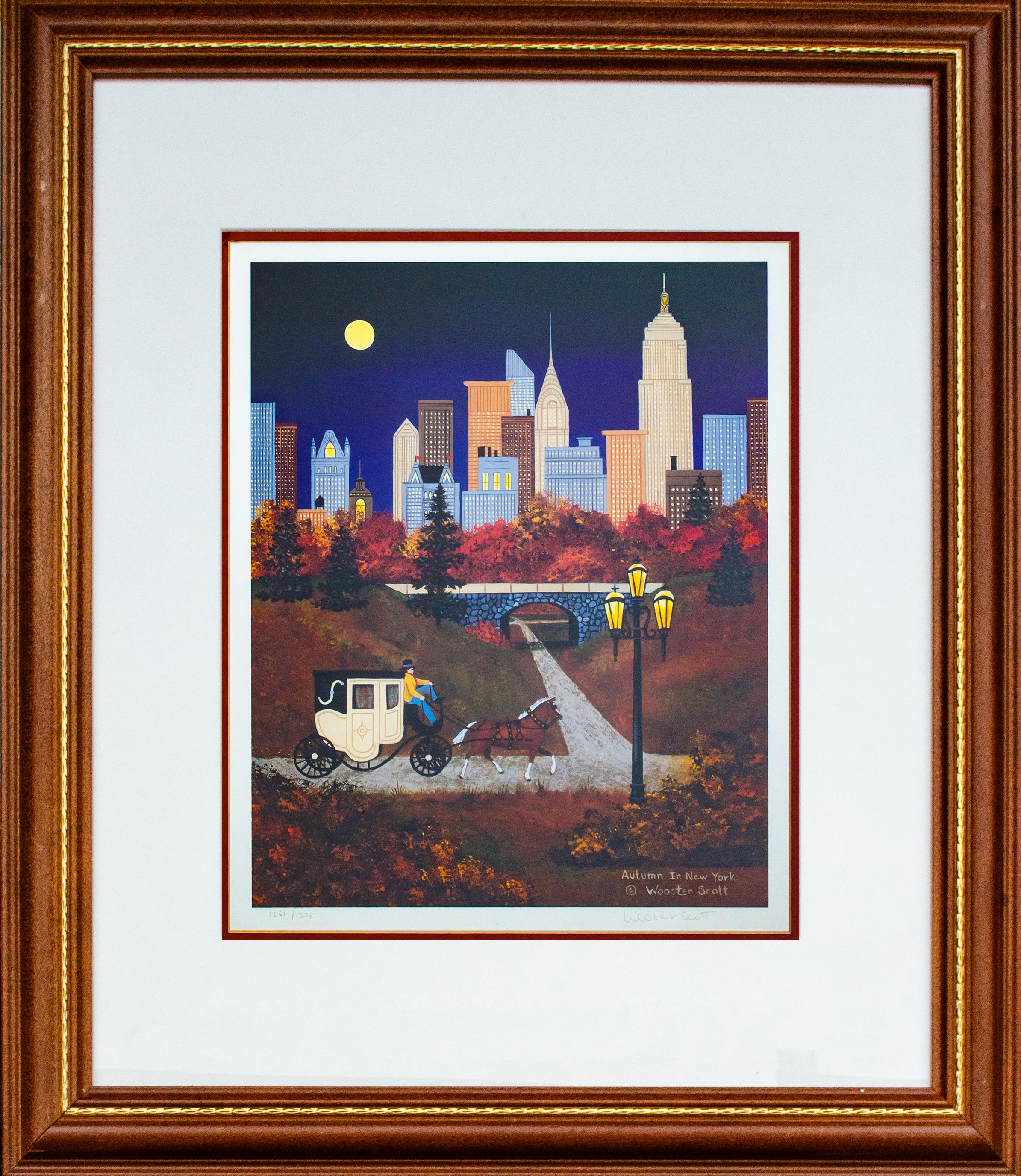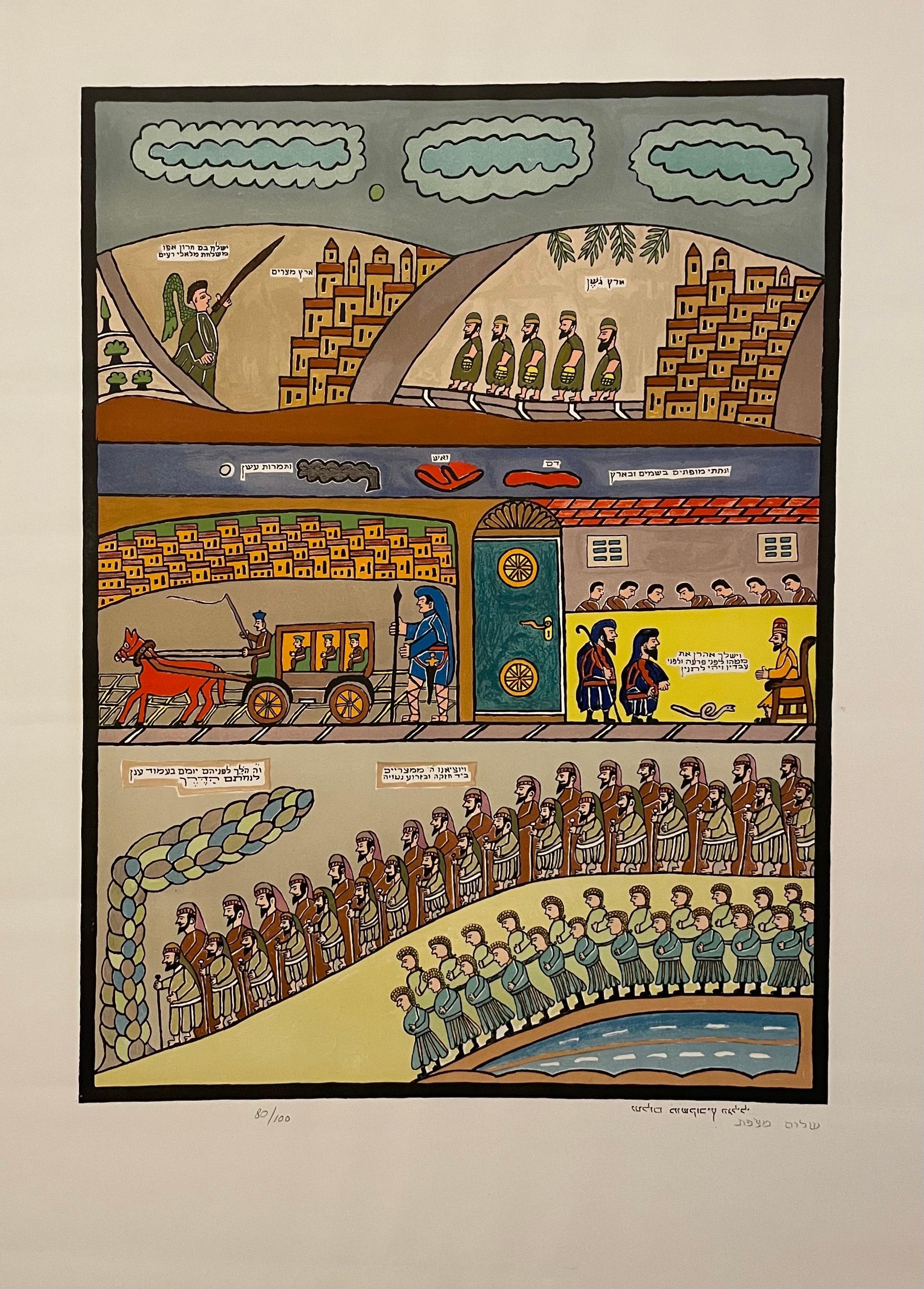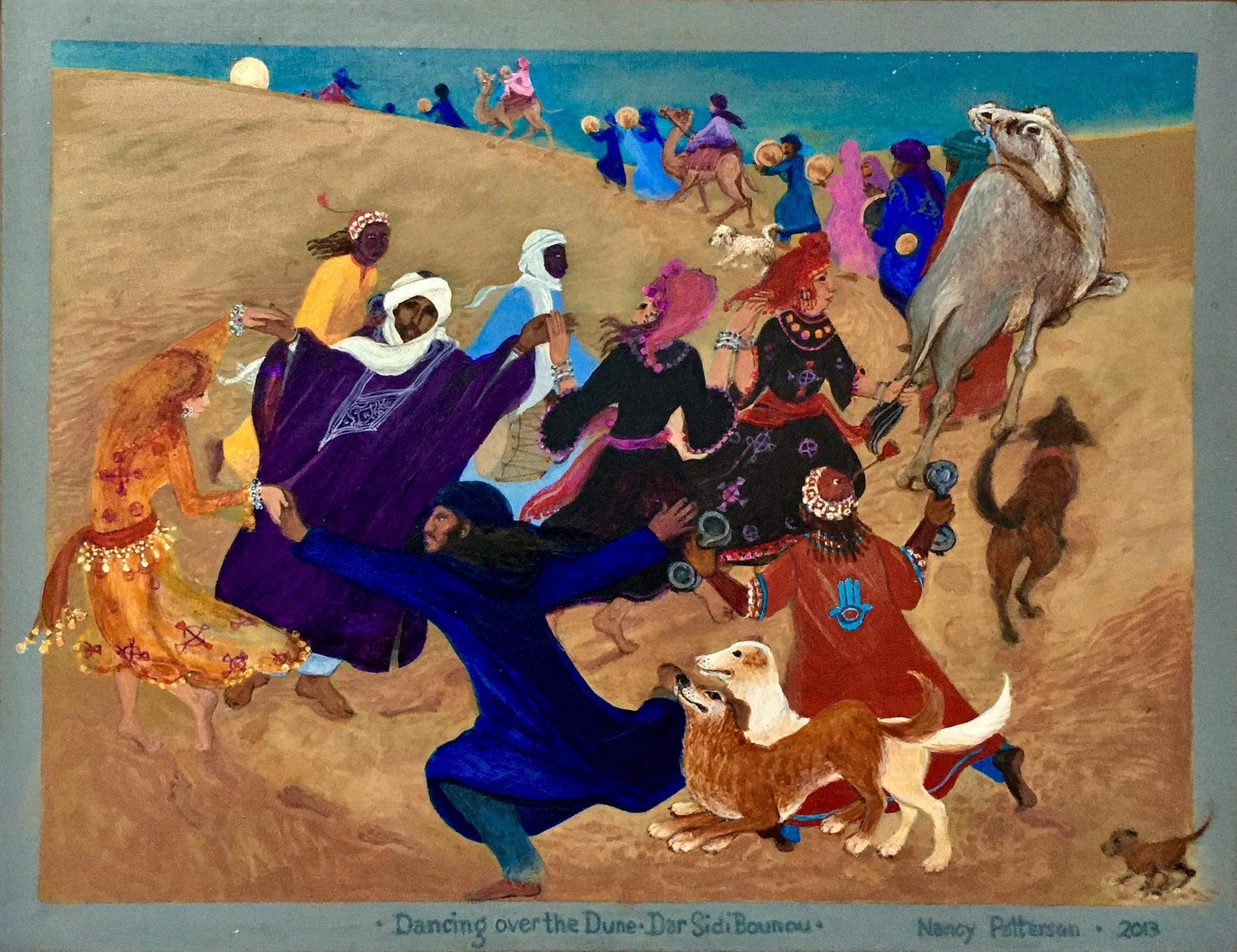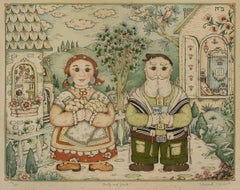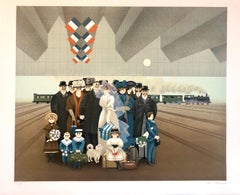Sorting Crabs, Sitka Cannery
View Similar Items
Want more images or videos?
Request additional images or videos from the seller
1 of 11
Rie MunozSorting Crabs, Sitka Cannery1989
1989
About the Item
- Creator:Rie Munoz (American)
- Creation Year:1989
- Dimensions:Height: 15 in (38.1 cm)Width: 18.75 in (47.63 cm)Depth: 0.65 in (1.66 cm)
- Medium:
- Movement & Style:
- Period:
- Condition:
- Gallery Location:San Francisco, CA
- Reference Number:Seller: mun/sor/cra/011stDibs: LU66638688262
About the Seller
5.0
Platinum Seller
These expertly vetted sellers are 1stDibs' most experienced sellers and are rated highest by our customers.
Established in 1999
1stDibs seller since 2017
683 sales on 1stDibs
Typical response time: 1 hour
More From This SellerView All
- Steam Bath, AniakLocated in San Francisco, CAThis artwork titled "Steam Bath, Aniak" 1995 is a color offset lithograph on paper by noted American artist Rie Mounier Munoz, 1921-2015. It is hand signed and numbered 38/950 in pencil by the artist. The image size is 6.75 x 10 inches, sheet size is 10.5 x 14 inches. It is in excellent condition.. About the artist: Alaska painter Rie Mounier Munoz was the child of Dutch parents who immigrated to California, where she was born and raised. She is known for her colorful scenes of everyday life in Alaska. Rie (from Marie) Munoz (moo nyos), studied art at Washington and Lee University in Virginia. In 1950, she traveled up the Inside Passage by steamship, fell in love with Juneau, and gave herself until the boat left the next day to find a job and a place to live. Since then Juneau has been home to Munoz. She began painting small vignettes of Alaska soon after arriving in Juneau, and also studied art at the University of Alaska-Juneau. Munoz painted in oils in what she describes as a "painstakingly realistic" style, which she found stiff and "somewhat boring." Her breakthrough came a few years later when an artist friend introduced her to a versatile, water-soluble paint called casein. The immediacy of this inexpensive medium prompted an entirely new style. Rie's paintings became colorful and carefree, mirroring her own optimistic attitude toward life. With her newfound technique she set about recording everyday scenes of Alaskans at work and at play. Of the many jobs she has held journalist, teacher, museum curator, artist, mother, Munoz recalls one of her most memorable was as a teacher on King Island in 1951, where she taught 25 Eskimo children. The island was a 13-hour umiak (a walrus skin boat) voyage from Nome, an experience she remembers vividly. After teaching in the Inupiat Eskimo village on the island with her husband during one school year, she felt a special affinity for Alaska's Native peoples and deliberately set about recording their traditional lifestyles that she knew to be changing very fast. For the next twenty years, Rie practiced her art as a "Sunday painter," in and around prospecting with her husband, raising a son, and working as a freelance commercial artist, illustrator, cartoonist, and curator of exhibits for the Alaska State Museum. During her years in Alaska, Munoz has lived in a variety of small Alaskan communities, including prospecting and mining camps. Her paintings reflect an interest in the day-to-day activities of village life such as fishing, berry picking, children at play, as well as her love of folklore and legends. Munoz says that what has appealed to her most were "images you might not think an artist would want to paint," such as people butchering crab, skinning a seal, or doing their laundry in a hand-cranked washing machine. In 1972, with her hand-cut stencil and serigraph prints selling well in four locations in Alaska, she felt confident enough to leave her job at the Alaska State Museum and devote herself full time to her art. Freed from the constraints of an office job, she began to produce close to a hundred paintings a year, in addition to stone lithograph and serigraph prints. From her earliest days as an artist, Rie had firm beliefs about selling her work. First, she insisted the edition size should be kept modest. When she decided in 1973 to reproduce Eskimo Story Teller as an offset lithography print and found the minimum print run to be 500, she destroyed 200 of the prints. She did the same with King Island, her second reproduction. Reluctantly, to meet market demand, she increased the edition size of the reproductions to 500 and then 750. The editions stayed at that level for almost ten years before climbing to 950 and 1250. Her work has been exhibited many solo watercolor exhibits in Alaska, Oregon and Washington State, including the Charles and Emma Frye Art Museum, Alaska State Museum in Juneau, Anchorage Historical and Fine Arts Museum, Tongass Historical Museum in Ketchikan, and Yukon Regional Library in Whitehorse; Yukon Territory, and included in exhibits at the Smithsonian Institute and Russell Senate Office Building in Washington, D.C. Munozs paintings have graced the covers of countless publications, from cookbooks to mail order catalogs, and been published in magazines, newspapers, posters, calendars, and two previous collections of her work: Rie Munoz...Category
Late 20th Century Folk Art Nude Prints
MaterialsLithograph
- Singing in the Bath, Tenakee SpringsLocated in San Francisco, CAThis artwork titled "Singing in the Bath, Tenakee Springs" 1996 is a color offset lithograph on paper by noted American artist Rie Mounier Munoz, 1921-2015. It is hand signed and numbered 1077/1100 in pencil by the artist. The image size is 13.5 x 10 inches, sheet size is 16 x 12.35 inches. It is in excellent condition, has never been framed. About the artist: Alaska painter Rie Mounier Munoz was the child of Dutch parents who immigrated to California, where she was born and raised. She is known for her colorful scenes of everyday life in Alaska. Rie (from Marie) Munoz (moo nyos), studied art at Washington and Lee University in Virginia. In 1950, she traveled up the Inside Passage by steamship, fell in love with Juneau, and gave herself until the boat left the next day to find a job and a place to live. Since then Juneau has been home to Munoz. She began painting small vignettes of Alaska soon after arriving in Juneau, and also studied art at the University of Alaska-Juneau. Munoz painted in oils in what she describes as a "painstakingly realistic" style, which she found stiff and "somewhat boring." Her breakthrough came a few years later when an artist friend introduced her to a versatile, water-soluble paint called casein. The immediacy of this inexpensive medium prompted an entirely new style. Rie's paintings became colorful and carefree, mirroring her own optimistic attitude toward life. With her newfound technique she set about recording everyday scenes of Alaskans at work and at play. Of the many jobs she has held journalist, teacher, museum curator, artist, mother, Munoz recalls one of her most memorable was as a teacher on King Island in 1951, where she taught 25 Eskimo children. The island was a 13-hour umiak (a walrus skin boat) voyage from Nome, an experience she remembers vividly. After teaching in the Inupiat Eskimo village on the island with her husband during one school year, she felt a special affinity for Alaska's Native peoples and deliberately set about recording their traditional lifestyles that she knew to be changing very fast. For the next twenty years, Rie practiced her art as a "Sunday painter," in and around prospecting with her husband, raising a son, and working as a freelance commercial artist, illustrator, cartoonist, and curator of exhibits for the Alaska State Museum. During her years in Alaska, Munoz has lived in a variety of small Alaskan communities, including prospecting and mining camps. Her paintings reflect an interest in the day-to-day activities of village life such as fishing, berry picking, children at play, as well as her love of folklore and legends. Munoz says that what has appealed to her most were "images you might not think an artist would want to paint," such as people butchering crab, skinning a seal, or doing their laundry in a hand-cranked washing machine. In 1972, with her hand-cut stencil and serigraph prints selling well in four locations in Alaska, she felt confident enough to leave her job at the Alaska State Museum and devote herself full time to her art. Freed from the constraints of an office job, she began to produce close to a hundred paintings a year, in addition to stone lithograph and serigraph prints. From her earliest days as an artist, Rie had firm beliefs about selling her work. First, she insisted the edition size should be kept modest. When she decided in 1973 to reproduce Eskimo Story Teller as an offset lithography print and found the minimum print run to be 500, she destroyed 200 of the prints. She did the same with King Island, her second reproduction. Reluctantly, to meet market demand, she increased the edition size of the reproductions to 500 and then 750. The editions stayed at that level for almost ten years before climbing to 950 and 1250. Her work has been exhibited many solo watercolor exhibits in Alaska, Oregon and Washington State, including the Charles and Emma Frye Art Museum, Alaska State Museum in Juneau, Anchorage Historical and Fine Arts Museum, Tongass Historical Museum in Ketchikan, and Yukon Regional Library in Whitehorse; Yukon Territory, and included in exhibits at the Smithsonian Institute and Russell Senate Office Building in Washington, D.C. Munozs paintings have graced the covers of countless publications, from cookbooks to mail order catalogs, and been published in magazines, newspapers, posters, calendars, and two previous collections of her work: Rie Munoz...Category
Late 20th Century Folk Art Nude Prints
MaterialsLithograph
- Feeding the RavensLocated in San Francisco, CAThis artwork titled "Feeding the Ravens" 1997 is a color offset lithograph on paper by noted American artist Rie Mounier Munoz, 1921-2015. It is hand signed and numbered 29/950 in pencil by the artist. The image size is 9.65 x 8.35 inches, sheet size is 13.85 x 12.25 inches. It is in excellent condition, has never been framed. About the artist: Alaska painter Rie Mounier Munoz was the child of Dutch parents who immigrated to California, where she was born and raised. She is known for her colorful scenes of everyday life in Alaska. Rie (from Marie) Munoz (moo nyos), studied art at Washington and Lee University in Virginia. In 1950, she traveled up the Inside Passage by steamship, fell in love with Juneau, and gave herself until the boat left the next day to find a job and a place to live. Since then Juneau has been home to Munoz. She began painting small vignettes of Alaska soon after arriving in Juneau, and also studied art at the University of Alaska-Juneau. Munoz painted in oils in what she describes as a "painstakingly realistic" style, which she found stiff and "somewhat boring." Her breakthrough came a few years later when an artist friend introduced her to a versatile, water-soluble paint called casein. The immediacy of this inexpensive medium prompted an entirely new style. Rie's paintings became colorful and carefree, mirroring her own optimistic attitude toward life. With her newfound technique she set about recording everyday scenes of Alaskans at work and at play. Of the many jobs she has held journalist, teacher, museum curator, artist, mother, Munoz recalls one of her most memorable was as a teacher on King Island in 1951, where she taught 25 Eskimo children. The island was a 13-hour umiak (a walrus skin boat) voyage from Nome, an experience she remembers vividly. After teaching in the Inupiat Eskimo village on the island with her husband during one school year, she felt a special affinity for Alaska's Native peoples and deliberately set about recording their traditional lifestyles that she knew to be changing very fast. For the next twenty years, Rie practiced her art as a "Sunday painter," in and around prospecting with her husband, raising a son, and working as a freelance commercial artist, illustrator, cartoonist, and curator of exhibits for the Alaska State Museum. During her years in Alaska, Munoz has lived in a variety of small Alaskan communities, including prospecting and mining camps. Her paintings reflect an interest in the day-to-day activities of village life such as fishing, berry picking, children at play, as well as her love of folklore and legends. Munoz says that what has appealed to her most were "images you might not think an artist would want to paint," such as people butchering crab, skinning a seal, or doing their laundry in a hand-cranked washing machine. In 1972, with her hand-cut stencil and serigraph prints selling well in four locations in Alaska, she felt confident enough to leave her job at the Alaska State Museum and devote herself full time to her art. Freed from the constraints of an office job, she began to produce close to a hundred paintings a year, in addition to stone lithograph and serigraph prints. From her earliest days as an artist, Rie had firm beliefs about selling her work. First, she insisted the edition size should be kept modest. When she decided in 1973 to reproduce Eskimo Story Teller as an offset lithography print and found the minimum print run to be 500, she destroyed 200 of the prints. She did the same with King Island, her second reproduction. Reluctantly, to meet market demand, she increased the edition size of the reproductions to 500 and then 750. The editions stayed at that level for almost ten years before climbing to 950 and 1250. Her work has been exhibited many solo watercolor exhibits in Alaska, Oregon and Washington State, including the Charles and Emma Frye Art Museum, Alaska State Museum in Juneau, Anchorage Historical and Fine Arts Museum, Tongass Historical Museum in Ketchikan, and Yukon Regional Library in Whitehorse; Yukon Territory, and included in exhibits at the Smithsonian Institute and Russell Senate Office Building in Washington, D.C. Munozs paintings have graced the covers of countless publications, from cookbooks to mail order catalogs, and been published in magazines, newspapers, posters, calendars, and two previous collections of her work: Rie Munoz...Category
Late 20th Century Folk Art Animal Prints
MaterialsLithograph
- Village en HiverLocated in San Francisco, CAThis artwork "Village en Hiver" c.1980 is an original color lithograph by French artist Madeleine (Mady) De La Giraudiere, 1922-2018. It is hand signed a...Category
Late 20th Century Folk Art Figurative Prints
MaterialsLithograph
- Christ Washing Feet of DisciplesBy Sadao WatanabeLocated in San Francisco, CAArtist: Sadao Watanabe (1913-1996) Title: Christ Washing Feet of Disciples Year: 1970 Medium: Japanese Stencil Dyeing (kappazuri) with hand coloring Paper: washi paper Sheet Size: 27.75 x 23.25 inches Framed size: 34.75 x 30 inches Edition Size: 50; This one: 42/50 Signature: Brushed signature, date lower right, number lower left. This fine print is immediately recognizable as the work of Sadao Watanabe (1913-1996) It depicts Christ washing the feet of his disciples. The print and mat are in very good condition. It is floating; attached with three archival hinges to a mounting matboard in gray. It has a white mat. The framing is a simple white metal frame that is in good condition with some light scratches. Sadao Watanabe was born and raised in Tokyo. Watanabe was famous for his biblical prints rendered in the mingei (folk art) tradition of Japan. As a student of the master textile dye artist Serizawa Keisuke...Category
1970s Folk Art Figurative Prints
MaterialsPaper, Stencil
- Indian Summer in NantuckettBy Jane Wooster ScottLocated in San Francisco, CAThis artwork titled "Indian Summer in Nantuckett" is an original offset lithograph on wove paper by American artist Jane Wooster Scott, born 1933. It is hand signed and numbered 681/750 in pencil by the artist. The image size is 27 x 20 inches, framed size is 39 x 32.25 inches. It is beautifully framed in a custom wood frame. It is in excellent condition. About the artist. Jane Wooster Scott grew up in the Philadelphia area and moved West following her dream to be a movie star. She quickly learned that goal was not for her, but became the host of a talk show where she interviewed movie stars. She photographs what she sees to recapture them later on canvas. However, few of her paintings are real, existing scenes. They are compositions drawn from her personal imagination. She has been exhibiting her work in Los Angeles and New York and most of her shows have completely sold out on opening night. In the "Guinness Book of Records" as one of the most reproduced artists in America, Jane Wooster Scott began copying work by folk artists such as Grandma Moses and gradually evolved into her own style. A turning point for her career was a joint showing at the Ankrum Gallery in Los Angeles with her comedian friend, Jonathan Winters. It was mostly a business crowd, and she sold 40 paintings in an hour. Her works hang in museums, in public buildings and private homes in Europe, Asia and South America as well as in the United States. She has become legendary for her exceptional scenes of America s celebrations and holidays, Among her collectors are Aaron Spelling, Sylvester Stallone, Charles Bronson, Kenny Rogers, Farah...Category
Late 20th Century Folk Art Figurative Prints
MaterialsOffset
You May Also Like
- Bubby and Zayde, Judaica Folk Art Jewish LithographBy Michoel MuchnikLocated in Surfside, FLThe title of the piece makes reference to the subject of the piece, in this case Bubby (Grandmother in Yiddish) and Zayde (Grandfather in Yiddish). In terms of style, it looks illustrative, cartoonist, and fairy-tale like. Edition 76/260. Michoel Muchnik was born in Philadelphia in 1952. Muchnik received his artistic training at the Rhode Island School of Design. He later studied Jewish and Talmudic studies at the Rabbinical College of America in Morristown, New Jersey. Michoel Muchnik's art focuses on imaginative and joyful depictions of traditional and mystical Jewish and Hasidic themes. Muchnik has exhibited his work and lectured on Hasidic art throughout the United States as well as abroad. In 1977, Muchnik was selected alongside four other Hasidic artists, including Hendel Lieberman...Category
Late 20th Century Folk Art Figurative Prints
MaterialsLithograph
- Naive Lithograph Paris Train Station Wedding Party, Honeymoon Scene Folk ArtLocated in Surfside, FLHand signed, limited edition on BFK Rives French art paper. I believe the title is Honeymoon. Jan Balet (20 July 1913 in Bremen – 31 January 2009 in Estavayer le Lac, Switzerland), was a German/US-American painter, graphic artist and illustrator. Affected by the folk art style of naive art he worked particularly as a graphic artist and as an Illustrator of children's books. His works exhibit a dry wit and refreshingly candid, whimsical, satirical view of life. His uncle was the famous painter and illustrator Benno Eggert. Many well-known personalities of the time were friends of his grandfather, i.e. the painters Hans Purrmann, Karl Caspar, Maria Caspar-Filser (cousin of his mother), the writer Martin Andersen Nexo, the Swabian poet Wilhelm Schussen as well as the poet and writer Oskar Wöhrle. In 1929, at the age of 17, he moved to Berlin at the invitation of his father and studied Drawing at the college of Arts and Crafts (Kunstgewerbeschule Ost am Schlesischen Bahnhof). A year later, he went to live with his mother and his grandmother, in Munich. Balet transferred his studies to the Munich College of Arts but was dismissed in 1932. He went on to study with Professor Ege, at a private school for commercial art. During this time he also worked at an institute for lithography and for the art gallery Wallach. Balet rented his first small studio at the age of nineteen, where he manufactured and sold hand colored Bavarian woodcuts. 1934 he passed the entrance examination to the Akademie der Bildenden Künste München and undertook further studies with Olaf Gulbransson. His work is of a popular style similar to Michel Delacroix, Charles Fazzino and James Rizzi. In early 1938 Balet was recruited by the German military and because his ancestor's passport was not complete, he was forbidden to associate further with the Akademie der Bildenden Künste München. Later that year Balet emigrated to the USA, settled in New York and painted rustic furniture for a living. One winter he jobbed as a skiing teacher in Vermont and occasionally jobbed as an advertising commercial artist. Among other projects, he painted the cafeteria of the largest of New York's department stores R.H. Macy. From time to time Balet's designs appeared in the fashion magazine Mademoiselle and in 1943 he became Art Director at the magazine. Balet became so successful as a commercial artist that he was able to give up paid employment and start his own business. He worked for the radio station CBS, magazines such as Vogue, House and Garden, House Beautiful, The Saturday Evening Post, Glamour, Good Housekeeping, This week. After the war ended in 1945 he acquired U.S. citizenship. Balet commuted between his studio in New York and an old, boat house in the dunes of Montauk, Long Island, which he had converted to a studio where he painted and drew. His first children's book Amos and the Moon was published in 1948. Despite what was regarded in the USA as fashionable art Abstract, Op-art and Pop Art, Balet continued to paint in his own naif style. Art work (Children books and sketchbooks) 1948 Amos and the moon, Henry Z. Walck Verlag New York 1949 Ned, Ed and the lion 1951 What makes an orchestra 1959 The five Rollatinis, J. B. Lippincott Co. Verlag New York 1965 Joanjo, Pharos Verlag Basel 1966 Das Geschenk Eine portugiesische Weihnachtsgeschichte, Betz-Verlag München 1967 Der König und der Besenbinder, Betz-Verlag München 1969 Der Zaun, Otto Maier Verlag München 1969 Ladismaus, Betz-Verlag München 1979 Ein Skizzenbuch, Windecker Winkelpresse 1980 Katzen-Skizzen, Windecker Winkelpresse 1981 Skizzen-Paare, Windecker Winkelpresse 1981 Die Leihkatze oder Wie man Katzen lieben lernt, Windecker Winkelpresse (Author: Otto Schönberger) 1982 Paris-Skizzen, Windecker Winkelpresse 1984 Hellas-Skizzen, Windecker Winkelpresse 1993 Wasser-Skizzen, Edition Toni Pongratz 1994 Die Zeppeline des Jan Balet, Zeppelin-Museum Friedrichshafen (Taschenbuch) 2008 Angekommen: Gedichte (Author: Hans Skupy) Publicationen, which Jan Balet illustrated 1945 Alarcon, P.A.: Tales from the Spanish, Allentown 1948 Hanle-Zack, D.: The golden ladle, Chicago-New York 1952 Wing, H.: Rosalinda, Chicago 1953 Wing, H.: The lazy lion...Category
20th Century Folk Art Figurative Prints
MaterialsLithograph
- Hand signed Folk Art Naive lithograph on Arches Paper Paris Snowman SceneBy Michel DelacroixLocated in Surfside, FLLithograph in colors depicting an enchanted evening in Paris with a snowman and children playing outside the restaurant Chez Joseph on a winter day. Signed in bottom right margin "M...Category
20th Century Folk Art Figurative Prints
MaterialsLithograph
- Hand signed Folk Art Naive lithograph on Arches paper Paris Evening Cafe SceneBy Michel DelacroixLocated in Surfside, FLsize includes frame: 32.5" H x 26.5" W; Lithograph in colors depicting an enchanted evening in Paris with a bright cafe and a church or public building on a charming Paris square. ...Category
20th Century Folk Art Figurative Prints
MaterialsLithograph
- Israeli Folk Art Hebrew Naive Judaica Lithograph Jewish Holiday ShavuotBy Shalom MoskovitzLocated in Surfside, FLVintage pencil signed and numbered limited edition lithograph on deckle edged Arches paper. Shalom of Sefad (Shulem der Zeigermacher in Yiddish Shalom Moskowitz) Shalom of Tzfat liv...Category
20th Century Folk Art Figurative Prints
MaterialsLithograph
- Israeli Naive Art Screen Print Lithograph Jerusalem, Sanhedrin Old City Folk ArtBy Gabriel CohenLocated in Surfside, FLBold color lithograph, hand signed in pencil and numbered AP IX/X (artist’s proof 9/10), Jerusalem Print Workshop blind stamp lower right. On French Arches paper. Gabriel Cohen, Self taught, Naive painter was born in Paris in 1933, to parents from Jerusalem with a father who studied the kabbalah. Throughout World War II, the family hid from the Nazis in Paris. Images of Nazi soldiers appear in several of his paintings. In 1949, when Gabriel was 16, the family returned to Israel. They managed to save enough money to move back to the quarter where both parents were born: Ohel Moshe in Nachlaot. Gabriel served in the artillery corps and after the army, went back to live in his parents' house and earned a living polishing diamonds. The head of the polishing plant, who noticed his employee's artistic skill, allowed him to paint during work hours. He once asked Cohen if he could draw a tiger. Cohen drew him a tiger. And he did a lot of sculpting and painting on glass. He also loved to play the guitar, especially flamenco style. Critics say he is one of Israel's greatest naive-style painters. Along with Shalom of Safed, Kopel Gurwin and Natan Heber, He is renowned as one of Israel's greatest living naive-style folk art painters, recipient of the Jerusalem Prize for Art (1987), a permanent entry in encyclopedias of naive painting, who exhibited his work not only in Israel, but also in Paris, Venezuela, Denmark and Germany; the same Gabriel Cohen whose colorful , bold paintings were exhibited at the Jewish Museum in New York in 1987 alongside works by Marc Chagall; the same Gabriel Cohen about whom curator and art scholar Gideon Ofrat says, "There is no questioning his greatness." He has shown in Paris on the Rue de Rosiers in the Marais. His impressions of his journeys, mostly imaginary, yet some real, are expressed in Cohen's paintings. Huge, colorful canvases rich in precise detail and fantasy, in which he paints the Eiffel Tower and the Russian steppes or the vistas of Paris and the Tower of Babel "In my opinion, it's also because the Tower of Babel has some kind of phallic, erotic meaning, but also because of the internationalism, of the mixture and confusion of nations, which is an essential element in Gabi Cohen's work," says Gideon Ofrat. There is no superlative that has not been lavished on Cohen's work by art critics, since he began showing his paintings at age 40, All the art critics seemed to agree at once that Cohen is one of the greatest naive-style painters in Israel. Their counterparts abroad seconded this view. About a year and a half ago, Zadka organized a show for Cohen at the Jerusalem Artists' House. The Tel Aviv Museum bought a painting of Gabi's and so did the Israel Museum, and several artists bought his drawings. He is a great, great painter. There is no painter who is more of a symbolist and illustrative artist than he is. As a painter myself, I admire him." The Yom Kippur War in 1973 sparked an artistic breakthrough for Cohen; it was at that time that he began to sit on the sidewalk after his work as a diamond polisher and paint. Not long afterward, in early 1974, he did a painting he called "Moses on the Mountain." Ruth Debel, of the Debel Gallery in Ein Kerem, passed by and saw it on the street. She asked how much he wanted for it, and for the first time in his life, he realized that his work had financial value. His first show was at the Debel Gallery in 1974. The response was overwhelming. Cohen was immediately declared a genius. His paintings at the gallery were purchased and he continued to create new paintings. That same year, he was invited to take part in a group exhibition of naive artists at the Kunsthaus in Zurich, and a year later, his work was included in a traveling show of naive-style artists from Israel that was exhibited in Denmark and Germany. Soon after that he was invited to be part of group shows in Venezuela and at the Tel Aviv Museum. Cohen had four solo shows at the Debel Gallery. Awards And Prizes 1987 Jerusalem Prize for Painting and Sculpture 1999 Shoshana Ish-Shalom Prize for special contribution to art, Jerusalem He has exhibited alngside all of the Israeli great artists. including Naive Art Group exhibition Gvanim Art Gallery, Jerusalem Rubin, Rachel Roman, Yitzhak Zarembo, Leah Moscovitz, Shalom (of Safed) Steinberg, Michael Danisov, Salva Harbon, Haim Cohen, Gabriel Chanannia, Joseph (Jojo) Local Hero...Category
20th Century Folk Art Landscape Prints
MaterialsScreen, Lithograph
Recently Viewed
View AllMore Ways To Browse
Poster Steamship
Retro Camping Poster
Vintage Crab Signs
Poster Vintage Voyage
Steamship Silver
Retro Hand Held Mirror
Retro Hand Held Mirrors
Emma Stone
Vintage Boat Mirror
Vintage Hand Crank
Oregon Poster
Dutch Mirror Hand Painted
Norway King
Retro Norwegian Posters
Climbing Poster
Laundry Sign
Traditional Style White Painted Full Size
Eskimo Prints


